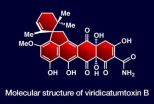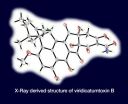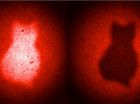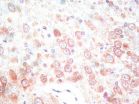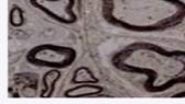(Press-News.org) HOUSTON – (Aug. 28, 2014) – A fortuitous collaboration at Rice University has led to the total synthesis of a recently discovered natural antibiotic.
The laboratory recreation of a fungus-derived antibiotic, viridicatumtoxin B, may someday help bolster the fight against bacteria that evolve resistance to treatments in hospitals and clinics around the world.
As part of the process, Rice organic chemist K.C. Nicolaou and structural biologist Yousif Shamoo and their colleagues created and tested a number of variants of viridicatumtoxin B that could lead to the simplified synthesis of a new generation of more effective antibiotics.
The work reported this month in the Journal of the American Chemical Society (JACS) focused on a tetracycline discovered in 2008 by scientists who isolated small amounts from penicillium fungi. The yield wasn't nearly enough for extensive testing, but it provided a basis for the discoverers to analyze its structure through magnetic resonance imaging, Nicolaou said.
"We're inspired by molecules that are biologically active and have the potential to become medicines one day," he said.
The new discovery belongs to a class of antibiotics known as tetracyclines for their distinctive molecular structure. They proved potent in initial tests on Gram-positive bacteria, so named for a staining technique to mark bacteria that are more susceptible to antibiotics than their Gram-negative counterparts.
The first tetracyclines, discovered in the late 1940s, ushered in a new class of powerful antibacterial agents to treat high-mortality diseases, among them anthrax and plague as well as such bacterial infections as chlamydia, syphilis and Lyme disease.
To find new weapons, especially against "superbugs" that resist nearly all antibiotics, synthetic chemists pursue the complex process of mimicking the structures of effective natural molecules as they build drug candidates atom by atom.
"Tetracyclines are widespread antibiotics today, but bacteria are building resistance to a lot of them," Nicolaou said. "This new tetracycline is not plentiful in nature, so the only way we can make it available to study by biologists for its potential in medicine is to synthesize it in the laboratory."
Three years of effort led the chemists working at Rice's BioScience Research Collaborative to find a structure that not only matches that of natural viridicatumtoxin B, but also allows the possibility of synthetic variants that could match or surpass its antibiotic potency.
Nicolaou, who is best known for synthesizing the widely used anticancer drug taxol and the chemotherapy agent calicheamicin, said the complicated new molecule offered a challenge he couldn't resist. "The structure (the discoverers) assigned to this molecule was suspicious to us. We didn't actually believe that it was correct," he said.
"Given this, we initiated a research program to synthesize this compound for three purposes," he said. "One was to develop new synthetic chemistry, which is always the case in these kinds of endeavors. Two was to synthesize the molecule itself and confirm its structure. Three was to use the technology we've developed to make analogs of it in the hope that we could find something simpler and yet better in terms of its biological and pharmacological properties."
Nicolaou's team met all of those goals and did indeed revise the structure of the molecule. The lab turned synthetic samples over to biologist Shamoo and his group for testing against a number of bacterial strains and comparison with natural viridicatumtoxin B.
"This was very exciting for us," said Nicolaou, who moved his lab from the Scripps Research Institute and the University of California at San Diego last year to form these kinds of collaborations. "In order to investigate the biological properties of our synthesized compounds, we turned to the Shamoo laboratory for its expertise in the area of antibiotics and drug-resistant bacteria."
The biologists reported that the synthetic version performed as well as the natural, and analogs lacking a hydroxyl group were even more effective against the same Gram-positive bacteria. The results also suggested the possibility of making variants by modifying certain domains of the molecule to improve its overall pharmacological properties.
"The most important finding was that simpler variations that are easier to make are showing equal if not better activity than the natural substance," Nicolaou said.
"My lab was really excited about working with K.C.'s group," Shamoo said. "Our expertise in antibiotic resistance and his synthesis of viridicatumtoxin B and analogs were a perfect opportunity for us to work together on an important problem."
Nicolaou acknowledged it could be years – even decades – before an antibiotic derived from viridicatumtoxin B is available to patients. But, he said, careful research from the start pays dividends in the long term, and the tools developed through the process should prove valuable in the synthesis of other fungal tetracyclines.
"Even though you find something that looks good, you shouldn't take the first substance from the shelf and run to develop it into a drug," he said. "We have to worry about solubility, biodegradation, availability and so many different things before we can get on the path of clinical development, because that part of the process is very expensive. We want to be sure at the research stage that we're doing everything we can to ensure the success of our chosen drug candidate."
The subject is very much on his mind these days. In this month's print edition of the journal Angewandte Chemie, Nicolaou laid out strategies for drug development to make what he called "one of the most challenging and difficult human endeavors" more efficient.
"It's said that for a drug to be discovered, a chemist has to make 10,000 compounds on average," he said. "It also means that it takes 12 to 15 years to develop a drug from the beginning to the end, and costs between $1.5 billion to $2 billion.
"Often, these things are not predictable, so experimentation is usually the final proof of what we're trying to do. That's what makes our collaborations at Rice so welcome and fruitful. The interface between chemistry and biology is the key to success in discovering drugs."
INFORMATION:
Co-authors of the JACS paper are graduate students Christopher Hale, Lizanne Nilewski and Kathryn Beabout and postdoctoral fellows Christian Nilewski, Heraklidia Ioannidou and Abdelatif El Marrouni, all of Rice, and Tim Wang, a Rice undergraduate student and Rice Century Scholar. Hale, Ioannidou, El Marrouni and Christian and Lizanne Nilewski came to Rice from the Scripps Research Institute, where they initiated the project in Nicolaou's lab; Lizanne Nilewski is now a second-year graduate student in the lab of Rice Professor James Tour. Shamoo is Rice's vice provost for research and a professor of biochemistry and cell biology. Nicolaou is the Harry C. and Olga K. Wiess Professor of Chemistry.
The National Institutes of Health, the Skaggs Institute of Research, the Cancer Prevention and Research Institute of Texas and the Welch Foundation supported the research.
David Ruth
713-348-6327
david@rice.edu
Mike Williams
713-348-6728
mikewilliams@rice.edu
Read the abstract at http://pubs.acs.org/doi/abs/10.1021/ja506472u
This news release can be found online at http://news.rice.edu/2014/08/28/synthesis-produces-new-antibiotic/
Follow Rice News and Media Relations via Twitter @RiceUNews
Related Materials:
K.C. Nicolaou Group: http://nicolaou.rice.edu/members.html
Shamoo Laboratory: http://www.bioc.rice.edu/~shamoo/shamoolab.html
Advancing the Drug Discovery and Development Process:
http://onlinelibrary.wiley.com/doi/10.1002/anie.201404761/abstract
Images for download:
http://news.rice.edu/wp-content/uploads/2014/08/0902_ANTIBIOTIC-1-WEB.jpg
The Rice University labs of organic chemist K.C. Nicolaou, left, and structural biologist Yousif Shamoo, right, collaborated on the project to synthesize and test variants of the fungi-derived antibiotic viridicatumtoxin B. The compound may someday help in the fight against bacteria that evolve resistance to treatment. (Credit: Tommy LaVergne/Rice University)
http://news.rice.edu/wp-content/uploads/2014/08/0902_ANTIBIOTIC-2-web.jpg
The molecular structure of viridicatumtoxin B, which has been synthesized and tested by scientists at Rice University. The natural antibiotic and its synthetic variants have potential to help wage the fight against resistant superbugs. (Credit: Nicolaou Group/Rice University)
http://news.rice.edu/wp-content/uploads/2014/08/0902_ANTIBIOTIC-3-WEB.jpg
The Rice University lab of synthetic chemist K.C. Nicolaou determined the structure of viridicatumtoxin B, a natural antibiotic, on the way to total synthesis of the compound. (Credit: Nicolaou Group/Rice University)
Located on a 300-acre forested campus in Houston, Rice University is consistently ranked among the nation's top 20 universities by U.S. News & World Report. Rice has highly respected schools of Architecture, Business, Continuing Studies, Engineering, Humanities, Music, Natural Sciences and Social Sciences and is home to the Baker Institute for Public Policy. With 3,920 undergraduates and 2,567 graduate students, Rice's undergraduate student-to-faculty ratio is just over 6-to-1. Its residential college system builds close-knit communities and lifelong friendships, just one reason why Rice is highly ranked for best quality of life by the Princeton Review and for best value among private universities by Kiplinger's Personal Finance. To read "What they're saying about Rice," go here.
Synthesis produces new antibiotic
Rice University scientists confirm potent synthesis of natural tetracycline
2014-08-28
ELSE PRESS RELEASES FROM THIS DATE:
Inter-dependent networks stress test
2014-08-28
Energy production systems are good examples of complex systems. Their infrastructure equipment requires ancillary sub-systems structured like a network—including water for cooling, transport to supply fuel, and ICT systems for control and management. Every step in the network chain is interconnected with a wider network and they are all mutually dependent. A team of UK-based scientists has studied various aspects of inter-network dependencies, not previously explored. The findings have been published in EPJ B by Gaihua Fu from Newcastle University, UK, and colleagues. These ...
Quantum physics enables revolutionary imaging method
2014-08-28
This news release is available in German. Researchers from the Institute for Quantum Optics and Quantum Information (IQOQI), the Vienna Center for Quantum Science and Technology (VCQ), and the University of Vienna have developed a fundamentally new quantum imaging technique with strikingly counterintuitive features. For the first time, an image has been obtained without ever detecting the light that was used to illuminate the imaged object, while the light revealing the image never touches the imaged object.
In general, to obtain an image of an object one has to illuminate ...
This is your brain's blood vessels on drugs
2014-08-28
WASHINGTON, Aug. 28, 2014—A new method for measuring and imaging how quickly blood flows in the brain could help doctors and researchers better understand how drug abuse affects the brain, which may aid in improving brain-cancer surgery and tissue engineering, and lead to better treatment options for recovering drug addicts. The new method, developed by a team of researchers from Stony Brook University in New York, USA and the U.S. National Institutes of Health, was published today in The Optical Society's (OSA) open-access journal Biomedical Optics Express.
The researchers ...
Ancient metal workers were not slaves but highly regarded craftsmen
2014-08-28
In 1934, American archaeologist Nelson Glueck named one of the largest known copper production sites of the Levant "Slaves' Hill." This hilltop station, located deep in Israel's Arava Valley, seemed to bear all the marks of an Iron Age slave camp – fiery furnaces, harsh desert conditions, and a massive barrier preventing escape. New evidence uncovered by Tel Aviv University archaeologists, however, overturns this entire narrative.
In the course of ongoing excavations at Timna Valley, Dr. Erez Ben-Yosef and Dr. Lidar Sapir-Hen of TAU's Department of Archaeology and Near ...
Global warming pioneer calls for CO2 to be taken from atmosphere and stored underground
2014-08-28
Wally Broeker, the first person to alert the world to Global Warming, has called for atmospheric CO2 to be captured and stored underground. He says that Carbon Capture, combined with limits on fossil fuel emissions, is the best way to avoid global warming getting out of control over the next fifty years. Professor Broeker (Columbia University, New York) made the call during his presentation to the International Carbon Conference in Reykjavik, Iceland, where 150 scientists are meeting to discuss Carbon Capture and Storage.
He was presenting an analysis which showed that ...
Neuroscientists watch imagination happening in the brain
2014-08-28
"You may say I'm a dreamer, but I'm not the only one," sang John Lennon in his 1971 song Imagine.
And thanks to the dreams of a BYU student, we now know more about where and how imagination happens in our brains.
Stefania Ashby and her faculty mentor devised experiments using MRI technology that would help them distinguish pure imagination from related processes like remembering.
"I was thinking a lot about planning for my own future and imagining myself in the future, and I started wondering how memory and imagination work together," Ashby said. "I wondered if they ...
Protected areas proven to protect biodiversity
2014-08-28
Protected areas conserve biodiversity and more action is needed to ensure safeguards are in place to protect these areas, researchers say.
Published in PLOS ONE, researchers from Monash University, Stellenbosch University and the University of Exeter, used meta-analysis - combining results from different studies - to look at the past 30 years of research into these areas, to determine whether they actually protect biodiversity.
Dr Bernard Coetzee, School of Biological Sciences, said protecting an area from human exploitation made common sense, however, up until now ...
Serotonin transporter is a mifepristone pharmacological target
2014-08-28
In the central nervous system, serotonergic transmission is critically regulated by serotonin reuptake through the serotonin transporter. As a crucial pharmacological target of antidepressants, the role of erotonin transporter in treatment of major depression is well-established. Dr. Chaokun Li and co-workers from Xinxiang Medical University in China cloned the human brain serotonin transporter into Xenopus oocytes, to establish an in vitro expression system. Two-electrode voltage clamp recordings were used to detect serotonin transporter activity. Their results show that ...
Vasopressin decreases neuronal apoptosis during cardiopulmonary resuscitation
2014-08-28
Epinephrine has been shown to be a first-choice drug for cardiopulmonary resuscitation. Nevertheless, its β-adrenergic effect probably increases myocardial oxygen consumption and leads to severe cardiac and cerebral injuries; moreover, epinephrine does not elevate long-term survival rates. The American Heart Association and the European Resuscitation Council recently recommended that vasopressin can be used for cardiopulmonary resuscitation, instead of epinephrine. However, the guidelines do not discuss the effects of vasopressin during cerebral resuscitation. According ...
Sciatic nerve repair using adhesive bonding and a modified conduit
2014-08-28
When repairing nerves with adhesives, most researchers place glue directly on the nerve stumps, but this method does not fix the nerve ends well and allows glue to easily invade the nerve ends. Ordinarily, nerve conduits are cylindrical. However, it is difficult to insert the nerve ends into the conduit because the nerve is soft and there is frictional resistance. Xiangdang Liang and co-workers from the General Hospital of Chinese PLA designed a special conduit for the adhesive technique and defined the best parameters for its use through in vitro testing, and then repaired ...
LAST 30 PRESS RELEASES:
New expert guidance urges caution before surgery for patients with treatment-resistant constipation
Solar hydrogen can now be produced efficiently without the scarce metal platinum
Sleeping in on weekends may help boost teens’ mental health
Study: Teens use cellphones for an hour a day at school
After more than two years of war, Palestinian children are hungry, denied education and “like the living dead”
The untold story of life with Prader-Willi syndrome - according to the siblings who live it
How the parasite that ‘gave up sex’ found more hosts – and why its victory won’t last
When is it time to jump? The boiling frog problem of AI use in physics education
Twitter data reveals partisan divide in understanding why pollen season's getting worse
AI is quick but risky for updating old software
Revolutionizing biosecurity: new multi-omics framework to transform invasive species management
From ancient herb to modern medicine: new review unveils the multi-targeted healing potential of Borago officinalis
Building a global scientific community: Biological Diversity Journal announces dual recruitment of Editorial Board and Youth Editorial Board members
Microbes that break down antibiotics help protect ecosystems under drug pollution
Smart biochar that remembers pollutants offers a new way to clean water and recycle biomass
Rice genes matter more than domestication in shaping plant microbiomes
Ticking time bomb: Some farmers report as many as 70 tick encounters over a 6-month period
Turning garden and crop waste into plastics
Scientists discover ‘platypus galaxies’ in the early universe
Seeing thyroid cancer in a new light: when AI meets label-free imaging in the operating room
Neutrophil-to-lymphocyte ratio may aid risk stratification in depressive disorder
2026 Seismological Society of America Annual Meeting
AI-powered ECG analysis offers promising path for early detection of chronic obstructive pulmonary disease, says Mount Sinai researchers
GIMM uncovers flaws in lab-grown heart cells and paves the way for improved treatments
Cracking the evolutionary code of sleep
Medications could help the aging brain cope with surgery, memory impairment
Back pain linked to worse sleep years later in men over 65, according to study
CDC urges ‘shared decision-making’ on some childhood vaccines; many unclear about what that means
New research finds that an ‘equal treatment’ approach to economic opportunity advertising can backfire
Researchers create shape-shifting, self-navigating microparticles
[Press-News.org] Synthesis produces new antibioticRice University scientists confirm potent synthesis of natural tetracycline

